Implementing the Axe Long Bat into Training
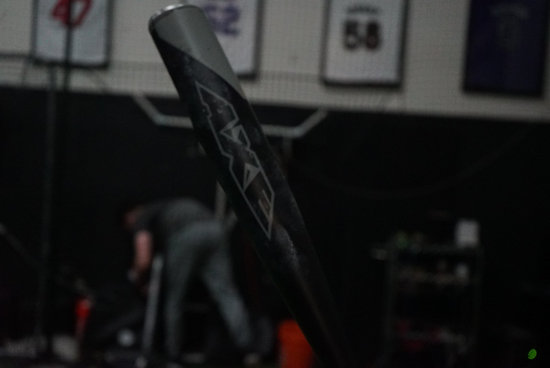
The Driveline Hitting Program is all about creating individualized programs to maximize player development. To accomplish this, we use several tools in varying degrees for each player, because each tool is designed to target specific swing flaws. The tools that people are most familiar with are our Hitting Plyo Ball ® and our Bat Speed Trainers, but another critical tool that’s used daily at Driveline is our Long Bat.
Long Bat Training has been a staple in our hitting program for a while, and considering Axe Bat has just released their metal Long Bat Trainer, this blog goes into the “what” and the “why” of Long Bat training.
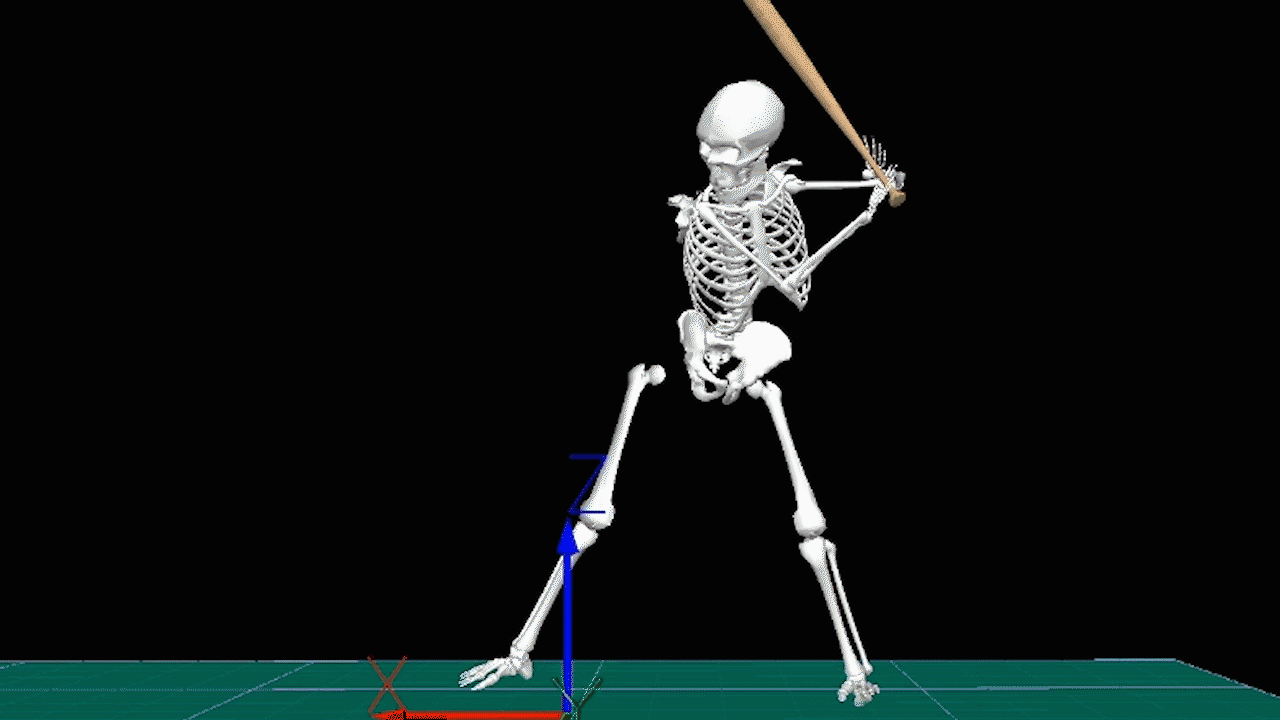
Foundations of Hitting
30 modules teaching you everything we know about hitting and hitting mechanics.
What Is the Long Bat?
It is a 37-inch, 37-ounce training bat. Along with training bat speed and supplementing the original Axe Bat speed trainers, the Long Bat Trainer assists in correcting some common swing flaws and can increase the amount of productive batted balls a hitter is able to produce. This blog addresses the benefits of the axe handle, overload/differential training, the swing flaws that long bats can address, and drill examples that we use regularly with the Axe Long Bat Trainer.
Benefits of the Axe Handle
The Axe handle has grown in popularity in recent years among players at all levels, most recently with 2018 American League MVP, Mookie Betts. The success of players like Betts, and other superstars who use the Axe handle, make it one of the most prominent changes to baseball equipment in recent years.
The Axe handle has been shown to assist hitters in obtaining a more natural grip in order to increase barrel speed, barrel control, and swing the bat comfortably and without pain. A study by Vijay Gupta PhD comparing the Axe handle to round-handled bats confirmed these notions and even found that the Axe handle promoted proper hand and grip kinematics to enhance efficiency in energy transfer from hand to barrel.
Training for bat speed and enhanced swing mechanics inherently requires a serious amount of concentrated, high-intent swings. Swinging with the Axe handle allows the hitter to take these reps more comfortably and safely, along with the peace of mind of knowing that he is gripping the bat as efficiently as possible. With the confirmed mechanical benefits of using an Axe handle along with comfort and a reduced injury risk, swinging an Axe handle as an overload in order to train bat speed and proper swing mechanics is the clear choice.

Become the Hitter You Want To Be
Train at Driveline
Benefits of Overload/Differential Training
Overload training is an absolute in any sport-training program, and the Axe Long Trainer certainly meets the criteria with overload in both weight and length of the bat. When swinging overload, we choose implements within 20% of the normal competition bat, because this is the optimal range for training speed and power. We choose 20% because extreme overload has been shown to cause detrimental changes to swinging or throwing kinematics. The dimensions of the long bat are 37 inches in length and 37 ounces in weight, right around the 20% criteria for a 33/34 inch bat. In this weight and length range, the hitter can create positive swing adaptations in both speed and mechanics because of the hitter’s ability to take high-intent swings without sacrificing movement quality.
As always, it is critical that the hitter swings overload bats at high intent in order to see the benefits of enhanced swing mechanics and bat speed. Swinging overload at considerably less than maximum intent can promote improper swing mechanics and a slower swing.
Overload training comes from the same concept as resistance training in weight lifting. Over time, resistance is increased in order to make gains in strength and power. Those who participate in overload training experience a period of supercompensation shortly after training. During this time, muscles have been broken down, built back up, and the athlete undergoes a training adaptation involving an increase in strength and power.
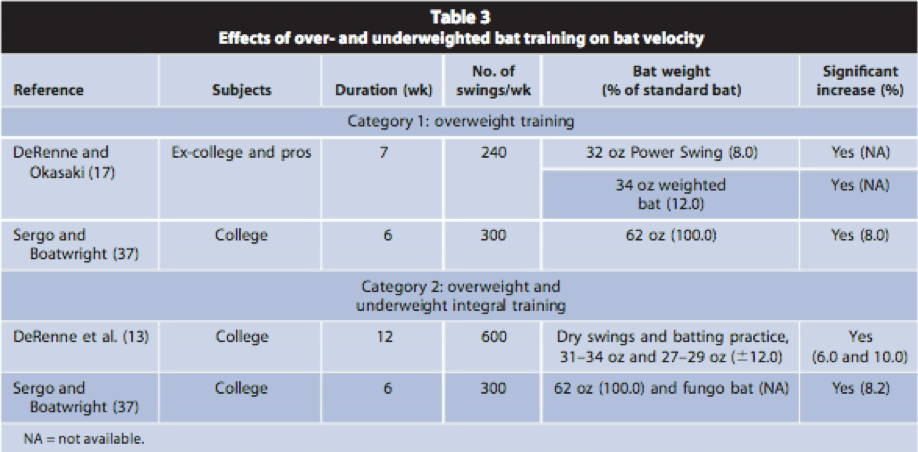
*Results of overload/underload training adopted from “Effects of Weighted Implement Training: A Brief Review.”
This concept is tried and true, and applying overload training to hitters is no exception to the rule. Rather than applying only resistance training in the weight room, the concept is applied to the swing by adding an overload aspect to the hitter’s bat. At some point, hitting a baseball will not be practiced without swinging overload/underload implements in order to increase bat speed and improve the hitter’s ability to produce batted balls at a higher exit velocity.
What makes the Axe Long Trainer unique as a training tool is the added benefit of differential training to increase proprioception and kinesthetic awareness. Training proprioception is essentially training “feel” for a task or an athletic endeavor and adding different weights, lengths, and shapes of an implement is a well-documented way to increase “feel.” This is the same concept used in the original Axe Bat speed trainer bats and differential command training and weighted balls used to train command in pitchers. The added length and weight of the bat provide a serious challenge to hitters when the intent is to square up the ball as consistently as possible. Essentially, if you can barrel a ball with the long bat consistently, you will be able to barrel balls with your game bat.
Differential training with the long bat or Axe Bat speed trainers can also be applied in-season for when the hitter goes through the inevitable slump. We are always fighting the battle between internal and external focus even despite the evidence that having the right external focus is far more effective than internally focusing on specific body parts.
“Studies suggest that athletes produce more force and sequence more efficiently when they focus externally versus internally. EMG activity showed that when the athlete focused on their body movement, there was a higher output of muscles that are not supposed to be activated, thus slowing down the body (Wulf, Su).” *From Director of Hitting Jason Ochart’s article on coaching hitting mechanics.
Rather than trying to make a mechanical “fix” and think internally, the hitter can pick up an Axe Long Trainer with the focus of barreling balls consistently. Once the hitter gets a feel for this task, switch to the game bat and barrel balls with the game bat. It sounds simple, but differential training has proven an effective training modality for finding the elusive “feel” that escapes every baseball player.
Swing Flaws and Characteristics
Since bat speed and correct mechanics are not necessarily mutually exclusive, long bats can help correct some common swing flaws while training bat speed. Specifically, we find that the Axe Long Trainer can assist in correcting late hip and torso rotation and inefficient kinematic sequencing. Paired with a focus on contact point and contact quality (ball flight and batted-ball spin), long bats can be an extremely effective implement in increasing a hitter’s ability to produce high exit-velocity batted balls at a line-drive trajectory on a consistent basis.
Note: As with every drill and training implement, it is not enough to simply swing the bat or swing as hard as possible. Intent is key when training and can shape mechanics much quicker than an internal focus or no focus at all. This is why it is imperative to hit the ball in all areas and depths of the zone and to swing with the intent to crush the ball and in the air. We strongly encourage Driveline trainees to swing the Axe Long Trainer with this intent at all times.
Because of the added load and increased length of the bat, swinging the long bat involves more activation from proximal segments such as the hips and torso rather than just swinging the bat with the hands. In general, power is created through ground force which is transferred through rotation. If hitters can train themselves to swing with more power from segments such as the hips and torso, energy will be transferred more efficiently to the hands and barrel of the bat.
For those with a “pushy” or hand-dominant swing, it is virtually impossible to swing the long trainer in the same manner a hitter would swing his game bat. The length and weight of the bat are simply too much to swing with just your hands. In order to even get the Axe Long Trainer’s barrel through the zone, the middle segments of the body (hips and torso) must be far more engaged than the hitter is used to.
For this reason, the long bat is able to assist in training hitters with late hip and torso rotation and poor sequencing patterns—two common flaws we see with hitters who come to train at Driveline.
Proper kinematic sequencing involves the hips reaching peak speed and decelerating first, followed by the torso, then the lead arm, and eventually the hands decelerate, transferring energy into the barrel of the bat. Because the Axe Long Trainer will not allow you to swing the bat with just your hands and arms, proper sequencing is promoted because the body knows it must move differently in order to get the length and weight of the bat through the zone.
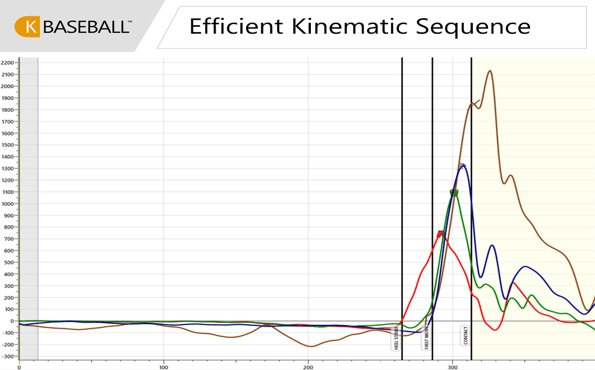
An example of an efficient kinematic sequence graph from K-Vest. The hips (red line) reach peak speed first, the torso (green line) follows, the lead arm (blue line) comes next, and finally the hands (brown line) peak last.
This addresses the mechanical issues by promoting earlier rotation with the hips, which in turn promotes earlier rotation with the torso, creating space and an elastic effect that propels the arms and hands through the zone. This is in contrast to rotating the arms and hands first and pushing the bat through the zone. The Axe Long Trainer is using the body’s ability to self-organize in order to promote a proper kinematic sequence and improve bat speed simultaneously.
Long Bat Drills
Walk Throughs
Walk Throughs are a standard drill at Driveline to develop bat speed and increase kinesthetic awareness. Taking a step and adding momentum to the swing can get the hitter a feel for increased bat speed as well as rhythm with his swing and with the pitcher. The Axe Long Trainer adds an extra challenge for consistent barrels.
The hitter starts behind the batter’s box as if he were going to take a step to throw. After one step, the thrower flips or throws the ball and the hitter swings with the intent of crushing a line drive.
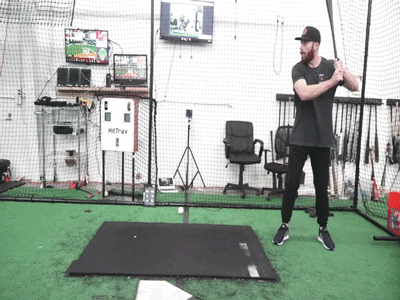
The intent here is to swing the bat fast and hit the ball as hard as possible. It is very important to swing at high intent during this drill and look to crush the baseball.
Keep It Fair Drill
The Keep It Fair drill is great for hitters with “pushy swings” and are late to clear their hips and upper body in order to get to the ball. This drill, paired with the Axe Long Trainer, provides a constraint for the hitter by not allowing a fair ball in play if the hitter does not sequence properly and compensates by rotating the arms and hands early. The batted ball will likely result in a hooked line drive or ground ball past the third or first base coach.
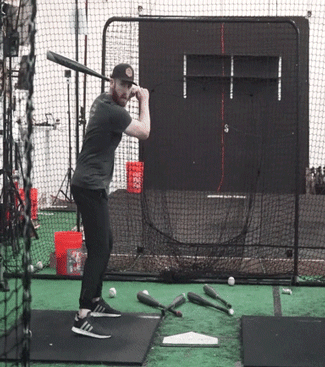
The thrower attempts to throw a pitch well off the inner third of the plate, close to the hitter’s body. The hitter expects this pitch and organizes to do damage on it by rotating ad decelerating the hips and torso first in order to create space for the barrel and hands to take a direct, slightly upward path towards the ball.
The key with this drill is to monitor ball flight. If the ball hooks or cuts, the hitter was likely late with hip and torso rotation, resulting in a hands-first path that has limited space to catch the ball flush.
For an added challenge, monitor the point of contact on each pitch. If the hitter was able to hit the ball hard to the pull side with minimal top or side spin, then challenge the hitter to hit the ball a few inches deeper.
Depth Ladder
Perhaps, one of our most effective and transferable drills to game play is the Depth Ladder. Today’s game requires the ability to hit balls flush at all depths in relation to the plate. Training this skill allows the hitter to swing with confidence knowing that his bat path can cover pitches in a large area of the hitting zone. Doing this drill with the Axe Long Trainer can further train the hitter’s ability to sequence properly as space must be created with the hips in torso in order for the hands to fire last and create swing depth. This enables the hitter to square balls up at line drive trajectory deep in the zone and out in front.
Start by placing three balls roughly six inches behind the front of home plate, just in front of the front of home plate, and six inches in front of the front of home plate.
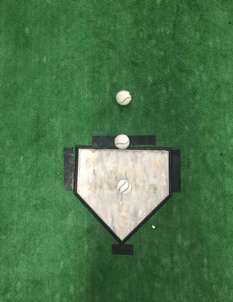
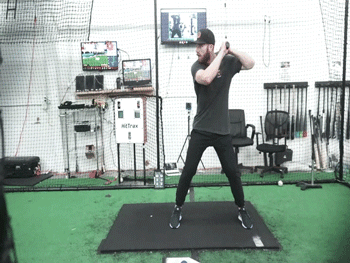
The hitter attempts to hit the ball at each depth on the plate (starting with the deepest ball) as hard as possible and at a positive launch angle. Once those parameters are met, the hitter moves on to the next depth and then back down the ladder. For extra challenge, set the launch angle and exit velocity thresholds higher. Another possibility can be mixing up pitch types and attempting to hit each pitch hard and in the air at a specific depth. (Be warned, this drill is extremely difficult!)
The Axe Long Trainer provides extra difficulty with overload length. Hitters will struggle to hit the ball deep on the plate and in the air. After the initial struggle with this drill, hitters will find their timing in rotating the hips and torso on time and having the hands and arms fire last. This will allow for flush contact deep in the zone and if maintained, flush contact out in front of the plate as well.
Find more information on the Axe Bat Long Trainer here:
Axe Bat Long Trainer, Powered by Driveline Baseball – DrivelinePlus
The Long Trainer is a 37″/37oz alloy 2-5/8″ bat for developing barrel awareness, speed and improving swing path. The increased length and weight of the bat helps you get a better feel for how your body and barrel move together during the swing. This is for the big boys and unlike anything you have ever swung!
Train at Driveline
Interested in training with us? Both in-gym and remote options are available!
- Athlete Questionnaire: Fill out with this link
- Email: support@drivelinebaseball.com
- Phone: 425-523-4030
Written by Hitting Coordinator Max Dutto
Comment section